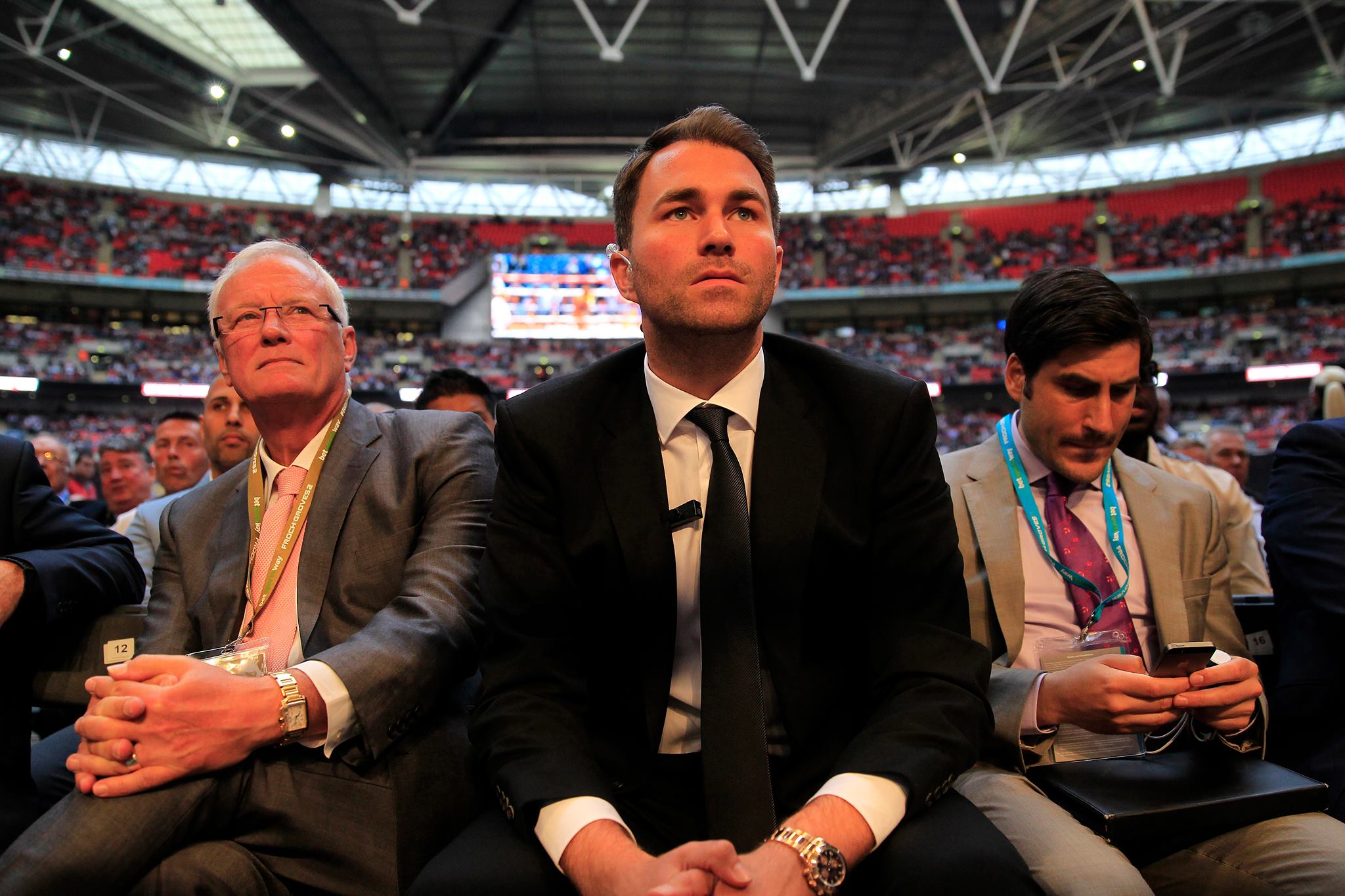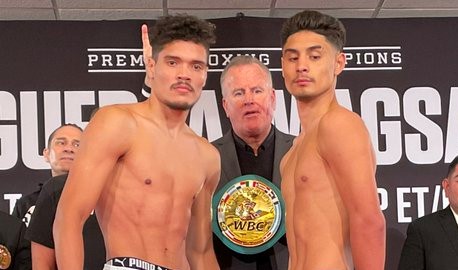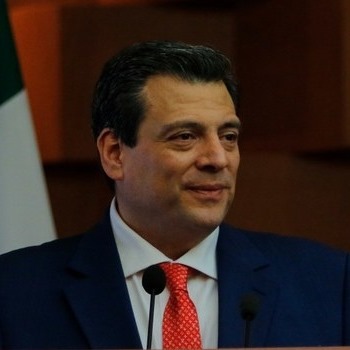By Stephanie Kent
Why WBC’s Jill Diamond is “cautiously optimistic” about the future of female fighting
Sports Illustrated has April 30th’s match between Katie Taylor and Amanda Serrano down for fight of the year, but is that enough to fix the systemic problems in women’s boxing? Jill Diamond, the International Secretary of the World Boxing Council, isn’t convinced that one great fight can be the game changing moment the sport needs.

Diamond, a recent NY State Boxing Hall of Fame inductee, fell into the boxing (and then, in love with boxing) through her late husband. While working out at Kingsway Boxing Gym in New York City in 2005, she got to know many of the female fighters training there and noticed some problems that still plague the sport today: namely, that women boxers train and fight as hard as their male counterparts, but earn just a fraction of the compensation and recognition for their work. “Women are passionate about what they do because they aren’t really in it for the money,” she says.
Jill emailed the World Boxing Council with her observations, and received a response from their president, José Sulaimán.
At the time, Jill says, women’s boxing was far from thriving. There were women fighters (women have boxed dating back to the early eighteenth century in London), but there were hardly any women who were household names. And no wonder – in the early aughts, a female world champion could only earn an upwards of $3,000.
“Women’s boxing was around before it was sanctioned,” says Diamond. “But they weren’t taken seriously. Promoters weren’t interested. In Mexico, boxing is boxing. In the United States, we struggled to give the women a platform. I met a bunch of women, but had never heard of anyone besides Christy Martin,” says Diamond. “They weren’t on TV. No promoters. They don’t make the same money, they don’t get the same attention.”
José Sulaimán shared Jill’s concern and she says after her email, he agreed: “For him, talent – not gender – is what’s important.”
The WBC extended an invitation to Jill to attend their annual convention that year, where they commited to support women in boxing. They launched the Women’s Championship Committee, which hosted international conventions to help women network, set up awards programs and rankings lists, helped them improve their skills around the business of boxing.
Over her years of work with the WBC and the Women’s Championship Committee, Diamond has seen the full spectrum of the sport. “There have been wonderful women’s fights that have fallen off the radar, with athletes who are so talented but just had bad timing.”
In recent years, women’s boxing has grown. The inclusion of women’s boxing in the Olympics has been internationally impactful in terms of driving interest to the sport; equally as important, the games have grown the talent pool significantly, launching the careers of popular professional fighters like Mikaela Mayer and Claressa Shields in the United States. Streaming services like ESPN+ and DAZN are promoting the hell out of women’s fights, like last month’s showdown between Katie Taylor and Amanda Serrano as the first ever women’s fight to headline Madison Square Garden.
Despite the historic fight, Diamond says, “They proved it could be done, proved they’re worthy . But we’ve seen great fights that don’t get momentum. I’m hopeful but not yet convinced. Taylor and Serrano have proven that it can be done, but there are still fewer opportunities to break out from. If you don’t have the exposure, you won’t have the opportunity to make a living. Amanda Serrano is full time. The thing Katie and Amanda have in common is that they are married to boxing. They have virtually no life out of the sport. Not everyone can do that. It’s the system, not the women.”
Still, Taylor-Serrano might offer some keys to success for the next big fight between women boxers. In looking back at that night at Madison Square Garden, Diamond recognizes some needle-movers for future fights.
The storied venue was certainly a key element, but more importantly, Taylor-Serrano offered a fight where fight fans really didn’t know who would win. The era of Christy Martin or Laila Ali plowing through unworthy opponents is over and for women’s boxing to thrive, promoters will need to create competitive match ups. Better promotion and marketing is sorely needed, too. WBC, DAZN, Matchroom, and Jake Paul’s Most Valuable Promotions gave a master class in spreading the word about Taylor-Serano.
Also important, Diamond says, is getting more women, more often, on the undercards of big fights. “People aren’t talking enough about how Franchon’s was a damn good fight too. Do they need great fights or can they be really good compelling fights? Not every fight is the best of all time. I would like to see every card have at least two out of those eight fights as women. Let it not be the exception. Still,” she says, “it’s up to fans to show promoters that they can take those risks. If we can prove there’s a fanbase, there will be more women’s fights.”
“I do feel hopeful. History was made, momentum has been created… It’s fresh now, what’s the next moment? Will it trickle down?”



















LarryFex
06/25/2024 at 3:46 am
pin up azerbaycan: pin up 360 – pin up az?rbaycan
AlbertImipt
06/25/2024 at 5:31 am
pin-up casino giris https://azerbaijancuisine.com/# pin-up 306
pin up yukle
Williamfrumn
06/26/2024 at 8:04 am
best online pharmacies in mexico: mexican pharmacy – medication from mexico pharmacy
JeffreyMok
06/26/2024 at 8:14 am
https://northern-doctors.org/# mexico pharmacy
Richardled
06/26/2024 at 10:18 am
mexican mail order pharmacies [url=https://northern-doctors.org/#]northern doctors[/url] reputable mexican pharmacies online
Williamfrumn
06/26/2024 at 10:29 am
п»їbest mexican online pharmacies: mexican northern doctors – reputable mexican pharmacies online
Williamfrumn
06/26/2024 at 5:32 pm
mexico pharmacy: Mexico pharmacy that ship to usa – mexican online pharmacies prescription drugs
Richardled
06/26/2024 at 5:45 pm
mexico drug stores pharmacies [url=http://northern-doctors.org/#]northern doctors pharmacy[/url] mexico drug stores pharmacies
Williamfrumn
06/26/2024 at 7:24 pm
best online pharmacies in mexico: buying prescription drugs in mexico online – purple pharmacy mexico price list
JeffreyMok
06/27/2024 at 4:59 am
https://northern-doctors.org/# medicine in mexico pharmacies
Williamfrumn
06/27/2024 at 6:35 am
buying prescription drugs in mexico: mexican pharmacy northern doctors – buying prescription drugs in mexico online
Williamfrumn
06/27/2024 at 8:27 am
mexican mail order pharmacies: mexico drug stores pharmacies – mexican rx online
Richardled
06/27/2024 at 10:06 am
mexico drug stores pharmacies [url=https://northern-doctors.org/#]mexican northern doctors[/url] mexican drugstore online
Williamfrumn
06/27/2024 at 10:27 am
reputable mexican pharmacies online: pharmacies in mexico that ship to usa – mexico pharmacies prescription drugs
Williamfrumn
06/27/2024 at 5:31 pm
mexican pharmaceuticals online: purple pharmacy mexico price list – buying prescription drugs in mexico online
Richardled
06/27/2024 at 7:10 pm
mexico pharmacies prescription drugs [url=https://northern-doctors.org/#]mexican northern doctors[/url] buying prescription drugs in mexico
Williamfrumn
06/27/2024 at 8:51 pm
buying from online mexican pharmacy: mexican pharmacy – best online pharmacies in mexico
Williamfrumn
06/27/2024 at 10:34 pm
mexican pharmaceuticals online: mexican pharmacy online – mexico pharmacy
Williamfrumn
06/28/2024 at 12:17 am
mexico drug stores pharmacies: mexican pharmacy northern doctors – buying prescription drugs in mexico
Richardled
06/28/2024 at 4:10 am
reputable mexican pharmacies online [url=https://northern-doctors.org/#]northern doctors pharmacy[/url] best online pharmacies in mexico
Williamfrumn
06/28/2024 at 5:04 am
reputable mexican pharmacies online: mexican pharmacy online – mexican drugstore online
Williamfrumn
06/28/2024 at 8:16 am
purple pharmacy mexico price list: northern doctors pharmacy – mexican mail order pharmacies
Williamfrumn
06/28/2024 at 9:55 am
mexican pharmaceuticals online: mexican pharmacy online – mexican pharmacy
JeffreyMok
06/28/2024 at 9:55 am
https://northern-doctors.org/# pharmacies in mexico that ship to usa
Williamfrumn
06/28/2024 at 11:37 am
mexican pharmacy: mexican pharmacy – mexico drug stores pharmacies
Richardled
06/28/2024 at 1:08 pm
buying prescription drugs in mexico online [url=http://northern-doctors.org/#]mexican pharmacy[/url] buying from online mexican pharmacy
Williamfrumn
06/28/2024 at 1:13 pm
buying prescription drugs in mexico online: mexico pharmacy – mexican pharmaceuticals online
JeffreyMok
06/28/2024 at 3:20 pm
http://northern-doctors.org/# mexican rx online
Williamfrumn
06/28/2024 at 4:36 pm
п»їbest mexican online pharmacies: mexican pharmacy – reputable mexican pharmacies online
JeffreyMok
06/28/2024 at 6:04 pm
http://northern-doctors.org/# mexican mail order pharmacies
Williamfrumn
06/28/2024 at 6:20 pm
best online pharmacies in mexico: Mexico pharmacy that ship to usa – mexican online pharmacies prescription drugs
Williamfrumn
06/28/2024 at 8:01 pm
buying from online mexican pharmacy: mexican pharmacy northern doctors – mexico drug stores pharmacies
Richardled
06/28/2024 at 10:12 pm
mexico drug stores pharmacies [url=https://northern-doctors.org/#]mexican pharmacy[/url] mexican border pharmacies shipping to usa
Williamfrumn
06/28/2024 at 11:18 pm
п»їbest mexican online pharmacies: northern doctors – medicine in mexico pharmacies
JeffreyMok
06/28/2024 at 11:19 pm
http://northern-doctors.org/# mexican drugstore online
Jeffreyber
06/29/2024 at 2:34 am
http://cmqpharma.com/# п»їbest mexican online pharmacies
mexican pharmacy
Ronnienop
06/29/2024 at 2:43 am
mexican rx online [url=http://cmqpharma.com/#]cmqpharma.com[/url] buying prescription drugs in mexico
Ronnienop
06/29/2024 at 2:05 pm
mexico pharmacy [url=http://cmqpharma.com/#]cmq mexican pharmacy online[/url] mexican rx online
Ronnienop
06/29/2024 at 5:07 pm
mexico drug stores pharmacies [url=http://cmqpharma.com/#]online mexican pharmacy[/url] mexico drug stores pharmacies
Ronnienop
06/29/2024 at 8:15 pm
п»їbest mexican online pharmacies [url=https://cmqpharma.online/#]cmq mexican pharmacy online[/url] mexican rx online
Ronnienop
06/29/2024 at 11:04 pm
mexican mail order pharmacies [url=https://cmqpharma.com/#]mexico pharmacy[/url] mexico pharmacies prescription drugs
Jeffreyber
07/02/2024 at 2:24 am
https://cmqpharma.online/# mexican pharmacy
mexican rx online
Ronnienop
07/02/2024 at 2:44 am
mexican pharmacy [url=http://cmqpharma.com/#]mexican pharmacy[/url] mexico drug stores pharmacies
Davidtoows
07/20/2024 at 12:48 am
reputable indian online pharmacy: buy medicines online in india – indian pharmacy
Michaelmoolo
07/20/2024 at 3:47 am
reputable indian pharmacies: india online pharmacy – indian pharmacies safe
Davidtoows
07/20/2024 at 5:52 am
reputable mexican pharmacies online: mexican pharmaceuticals online – mexico drug stores pharmacies
Davidtoows
07/20/2024 at 10:48 am
canadian pharmacy no rx needed: vipps canadian pharmacy – pharmacy rx world canada
Michaelmoolo
07/20/2024 at 1:11 pm
online shopping pharmacy india: india pharmacy – best online pharmacy india
Davidtoows
07/20/2024 at 4:40 pm
canadian drug pharmacy: canadian pharmacies compare – pharmacy canadian superstore
Davidtoows
07/20/2024 at 9:36 pm
buy medicines online in india: best online pharmacy india – top online pharmacy india
Michaelmoolo
07/20/2024 at 10:06 pm
canadian pharmacy tampa: buy drugs from canada – canadian drugs online
EdwardLoobe
07/21/2024 at 12:05 am
https://indiapharmast.com/# top online pharmacy india
Davidtoows
07/21/2024 at 2:50 am
canadian pharmacy service: canadian drugstore online – adderall canadian pharmacy
Michaelmoolo
07/21/2024 at 7:29 am
canadian pharmacy tampa: canadian family pharmacy – onlinecanadianpharmacy
Davidtoows
07/21/2024 at 7:42 am
pharmacies in mexico that ship to usa: purple pharmacy mexico price list – mexico pharmacies prescription drugs
Myronnepay
07/21/2024 at 1:20 pm
http://clomiddelivery.pro/# can i get clomid no prescription
can you buy amoxicillin uk [url=https://amoxildelivery.pro/#]can you buy amoxicillin uk[/url] amoxicillin price canada
Jamesjam
07/21/2024 at 3:22 pm
where buy generic clomid prices: order generic clomid no prescription – where to buy clomid without dr prescription
Thomaskef
07/21/2024 at 4:16 pm
http://doxycyclinedelivery.pro/# doxycycline pharmacy uk
Thomaskef
07/22/2024 at 12:17 am
https://amoxildelivery.pro/# amoxicillin capsule 500mg price
Thomaskef
07/22/2024 at 8:14 am
http://amoxildelivery.pro/# amoxil pharmacy
Myronnepay
07/22/2024 at 8:24 am
http://paxloviddelivery.pro/# paxlovid cost without insurance
buy cipro [url=https://ciprodelivery.pro/#]buy ciprofloxacin over the counter[/url] buy cipro cheap
Thomaskef
07/22/2024 at 4:14 pm
https://doxycyclinedelivery.pro/# doxycycline capsules
Jamesjam
07/22/2024 at 4:42 pm
buy cipro online without prescription: ciprofloxacin mail online – antibiotics cipro
Myronnepay
07/22/2024 at 6:07 pm
http://paxloviddelivery.pro/# paxlovid india
paxlovid cost without insurance [url=https://paxloviddelivery.pro/#]paxlovid buy[/url] п»їpaxlovid
Thomaskef
07/23/2024 at 12:07 am
https://paxloviddelivery.pro/# Paxlovid buy online
Myronnepay
07/23/2024 at 3:17 am
http://doxycyclinedelivery.pro/# doxycycline pharmacy price
п»їpaxlovid [url=https://paxloviddelivery.pro/#]Paxlovid over the counter[/url] paxlovid cost without insurance
Thomaskef
07/23/2024 at 7:30 am
https://amoxildelivery.pro/# amoxicillin 500 mg without a prescription
Myronnepay
07/23/2024 at 12:38 pm
https://ciprodelivery.pro/# ciprofloxacin order online
get cheap clomid no prescription [url=http://clomiddelivery.pro/#]can i get generic clomid online[/url] how to buy clomid without dr prescription
Thomaskef
07/23/2024 at 2:30 pm
https://amoxildelivery.pro/# amoxicillin 500 coupon
Jamesjam
07/23/2024 at 6:06 pm
doxycycline otc drug: doxycycline nz cost – doxycycline 100mg tablets
Thomaskef
07/23/2024 at 10:51 pm
http://ciprodelivery.pro/# buy cipro online without prescription
Thomaskef
07/24/2024 at 7:08 am
https://ciprodelivery.pro/# buy cipro cheap